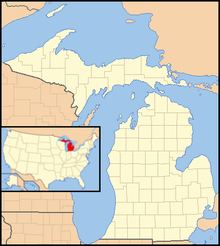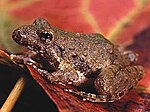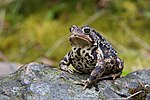List of amphibians of Michigan

Twenty-six amphibian species are found in
Endangered Species Act.[4]
Of the over 3400 species of frog and toad worldwide, the majority live in the
Amphibian habitats in Michigan are generally split into four regions: the northern and southern
mixed conifer/hardwood predominate. Swamps and bogs are found more often in Region Two than Region One. Region Three, the eastern Upper Peninsula, has a climate profile similar to Region Two. Sand and clay dominate the soil of this region, and tend to be low in nutrients and poorly drained. There are extensive wetlands, dominated by coniferous forests, while upland areas provide mixed conifer/broadleaf hardwood tracts. Region Four, the western Upper Peninsula, provides extensive bedrock structures. The temperature is less moderate than in the other three regions, and can see frigid winters and hot summers. Mixed conifer/broadleaf forests again predominate.[5]
Frogs
| Scientific name | Common name | Description | Image | Notes |
|---|---|---|---|---|
Acris crepitans blanchardi
|
Blanchard's cricket frog | Adults are approximately 1 inch (2.5 cm) long and are colored brown or gray. |  |
Considered a threatened species in Michigan.[3] |
Hyla chrysoscelis
|
Cope's gray tree frog | Adults are 1.5 to 2 inches (3.8 to 5.1 cm) long and colored gray, green or brown. |  |
|
Hyla versicolor
|
Gray tree frog | Adults are 1.5 to 2 inches (3.8 to 5.1 cm) long and colored gray, green or brown. |  |
|
Pseudacris crucifer crucifer
|
Northern spring peeper | Adults are 1 to 1.5 inches (2.5 to 3.8 cm) long and are colored light brown or tan. |  |
|
Pseudacris maculata
|
Boreal chorus frog | Adults are approximately 1.5 inches (3.8 cm) long and colored pale gray or brown, with a few individuals being red or bright green.[6] |  |
Occurs only on Isle Royale in Michigan,[7] considered a species of special concern.[3] |
Pseudacris triseriata triseriata
|
Western chorus frog | Adults are 1 to 1.5 inches (2.5 to 3.8 cm) long and are colored brown with dark stripes. |  |
|
Rana catesbeiana
|
Bullfrog | Adults are 3 to 8 inches (7.6 to 20.3 cm) long and colored green, brown or olive. |  |
|
Rana clamitans melanota
|
Northern green frog | Adults are 2.5 to 4 inches (6.4 to 10.2 cm) long and colored green, brown or olive. |  |
|
Rana palustris
|
Pickerel frog | Adults are 2 to 3 inches (5.1 to 7.6 cm) long and colored green or brown with dark square spots. |  |
|
Rana pipiens
|
Northern leopard frog | Adults are 2 to 3.5 inches (5.1 to 8.9 cm) and colored green or brown with dark round spots. |  |
|
Rana septentrionalis
|
Mink frog | Adults are 2 to 3 inches (5.1 to 7.6 cm) long and colored a blotchy green or brown. |  |
|
Rana sylvatica
|
Wood frog | Adults are 2 to 2.5 inches (5.1 to 6.4 cm) long and colored brown or tan. |  |
Salamanders
| Scientific name | Common name | Description | Image | Notes |
|---|---|---|---|---|
Ambystoma laterale
|
Blue-spotted salamander | Adults are 3.5 to 5.5 inches (8.9 to 14.0 cm) long and are colored black with turquoise or pale blue spots. |  |
|
Ambystoma maculatum
|
Spotted salamander | Adults are 4.3 to 9.8 inches (11 to 25 cm) long and are colored black or dark gray with round yellow spots. |  |
|
Ambystoma opacum
|
Marbled salamander | Adults are 3.5 to 5 inches (8.9 to 12.7 cm) long and are colored black or dark gray with white or gray markings. |  |
Considered an endangered species in Michigan.[3] |
Ambystoma texanum
|
Small-mouth salamander | Adults are 4.3 to 7 inches (11 to 18 cm) long and are colored black, gray or brown. |  |
Considered an endangered species in Michigan.[3] |
Ambystoma tigrinum tigrinum
|
Eastern tiger salamander | Adults are 7 to 13 inches (18 to 33 cm) long and are colored black, brown or olive with yellow or brown spots. |  |
|
| Ambystoma tremblayi | Tremblay's salamander | A three- A. jeffersonianum; difficult to distinguish visually from the former.[8] |
Has been noted near Ann Arbor, Michigan.[8] | |
Eurycea bislineata
|
Northern two-lined salamander | Adults reach 3.5 inches (8.9 cm) long and are generally yellow with two dark lines running the length of the body.[9] |  |
Only known to occur at Murphy Lake State Game Area in Tuscola County in eastern Michigan.[10] |
Hemidactylium scutatum
|
Four-toed salamander | Adults are 2 to 4 inches (5.1 to 10.2 cm) long and are colored orange to gray-brown, with small black or blue speckles. |  |
|
Necturus maculosus
|
Mudpuppy | Adults are 8 to 19 inches (20 to 48 cm) long and are colored black or gray-brown with dark splotches. |  |
|
Notophthalmus viridescens
|
Eastern newt | Adults are 2.5 to 5.5 inches (6.4 to 14.0 cm) long and are colored olive green to greenish brown. |  |
|
Plethodon cinereus
|
Red-backed salamander | Adults are 2.3 to 5 inches (5.8 to 12.7 cm) long and are generally darkly colored, with a red stripe on their back early in their life cycle. |  |
|
Siren intermedia nettingi
|
Western lesser siren | Adults are 7 to 19.7 inches (18 to 50 cm) long and are colored gray, brown or olive. |  |
Considered a species of special concern in Michigan.[3] |
Toads
See also
References
- General references
- "Michigan's Frogs & Toads". Michigan Department of Natural Resources. Retrieved 2012-03-09.
- "Michigan's Salamanders". Michigan Department of Natural Resources. Retrieved 2012-03-09.
- Specific references
- ^ a b c "Michigan's Frogs & Toads". Michigan Department of Natural Resources. Retrieved 2012-03-09.
- ^ a b c "Michigan's Salamanders". Michigan Department of Natural Resources. Retrieved 2012-03-09.
- ^ a b c d e f "Michigan's Special Animals". Michigan State University Extension. Retrieved 2012-03-09.
- ^ "Michigan: Endangered, Threatened and Candidate Species". US Fish and Wildlife Service. Archived from the original on 2012-02-21. Retrieved 2012-03-09.
- ^ Alan, Holman J. (Summer 2004). "Herpetological assemblages of the Michigan Regional Landscape Ecosystems". Michigan Academician. 36 (2): 165–190.
- ^ "Chorus Frogs". Checklist of Amphibian Species and Identification Guide. Northern Prairie Wildlife Research Center, US Geological Survey. Archived from the original on 2012-05-27. Retrieved 2012-03-25.
- ^ "Western Chorus Frog (Pseudacris triseriata triseriata)". Michigan Department of Natural Resources. Retrieved 2012-03-09.
- ^ .
- ^ "Northern Two-lined Salamander, Eurycea bislineata". Checklist of Amphibian Species and Identification Guide. US Geological Society. Retrieved 2012-04-18.
- ^ Soderberg, Nicole; Balash, Kim; Yoder, Teresa; Szuch, Ernest. "First State Records of the Two-lined Salamander in Michigan". Ohio Department of Natural Resources. Archived from the original on 2012-12-24. Retrieved 2012-04-18.


